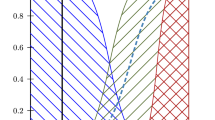Abstract
To realize the autonomous exploration and the cooperation behaviors of robots in the unknown environment, an improved internal model to evoke robots actions using a psychological theory of Russell was proposed in our previous work. The improved model is based on an affect-action model proposed by Ide and Nozawa group whose basic principle is to control the movement of robots by the degrees of “pleasure” and “arousal” of one’s own and the observation of others. To overcome the phenomena of “deadlock” and adapt to the complicated environment, “curiosity” factor is introduced into the basic model, and the action function is improved to be dynamically. This paper provides experimental comparison between the conventional model and our improved model with goal-exploration simulations. The results showed that only robots with the improved model moved dynamically and successfully reached at multiple goal areas avoiding local traps and obstacles in the complicated environment.












Similar content being viewed by others
References
Aleksander I. Designing conscious systems. Cognit Comput. 2009;1:22–8.
Cao YU, Fukunaga AS, Kahng AB. Cooperative mobile robotics: antecedents and directions. Auton Robots. 1997;4:7–27.
Asada M, Uchibe E, Hosoda K. Cooperative behavior acquisition for mobile robots in dynamically changing real worlds via vision-based reinforcement learning and development. Artif Intell. 1999;110:275–92.
Kuremoto T, Obayashi M, Kobayashi K, Adachi H, Yoneda K. A reinforcement learning system for swarm behaviors. In: Proceedings of IEEE World Congress on Computationl Intelligence. (WCCI/IJCNN 2008) 2008. p. 3710–5.
Kuremoto T, Obayashi M, Kobayashi K, Adachi H, Yoneda K. A neuro-fuzzy learning system for adaptive swarm behaviors dealing with continuous state space. In: Proceedings of International Conference on Intelligence Computation (ICIC 2008), vol 5227. Springer, LNAI; 2009. p. 675–83.
Kuremoto T, Obayashi M, Kobayashi K. Adaptive swarm behavior acquisition by a neuro-fuzzy system and reinforcement learning algorithm. Int J Intell Compuy Cybern. 2009;2(4):724–44.
Kuremoto T, Obayashi M, Kobayashi K. An improved internal model for swarm formation and adaptive swarm behavior acquisition. J Circuit Syst Comput. 2009;18(8):1517–31.
Sato S, Nozawa A, Ide H. Characteristics of behavior of robots with emotion model. IEEJ Trans EIS. 2004;124(7):1390–5. (in Japanese).
Kusano T, Nozawa A, Ide H. Emergent of burden sharing of robots with emotion model. IEEJ Trans EIS. 2005;125(7):1037–42. (in Japanese).
Russell JA. A circumplex model of affect. J Pers Soc Psychol. 1980;39(6):1161–78.
Larsen RJ, Diener E. Promises and problems with the circumplex model of emotion. In: Clark MS, editor. Rev. personality and social psychology: emotion, vol 13. Newbury Park, CA: Sage; 1992. p. 25–59.
Kuremoto T, Obayashi M, Kobayashi K, Feng L-B. Autonomic behaviors of swarm robots driven by emotion and curiosity. In: Li K editor, LSMS/ICSEE, vol 6630. Springer, LNBI; 2010. p. 541–7.
Oudeyer P-Y, Kaplan F. Intelligent adaptive curiosity: a source of self-development. In Proceedings of 4th International Workshop on Epigenetic Robotics; 2004. p. 12–132.
Acknowledgments
We would like to thank M. Sugino and Y. Matsusaki for their early work, and a part of this study was supported by JSPS-KAKENHI (No.20500207 and No.20500277).
Author information
Authors and Affiliations
Corresponding author
Rights and permissions
About this article
Cite this article
Kuremoto, T., Obayashi, M., Kobayashi, K. et al. An Improved Internal Model of Autonomous Robots by a Psychological Approach. Cogn Comput 3, 501–509 (2011). https://doi.org/10.1007/s12559-011-9102-7
Received:
Accepted:
Published:
Issue Date:
DOI: https://doi.org/10.1007/s12559-011-9102-7




